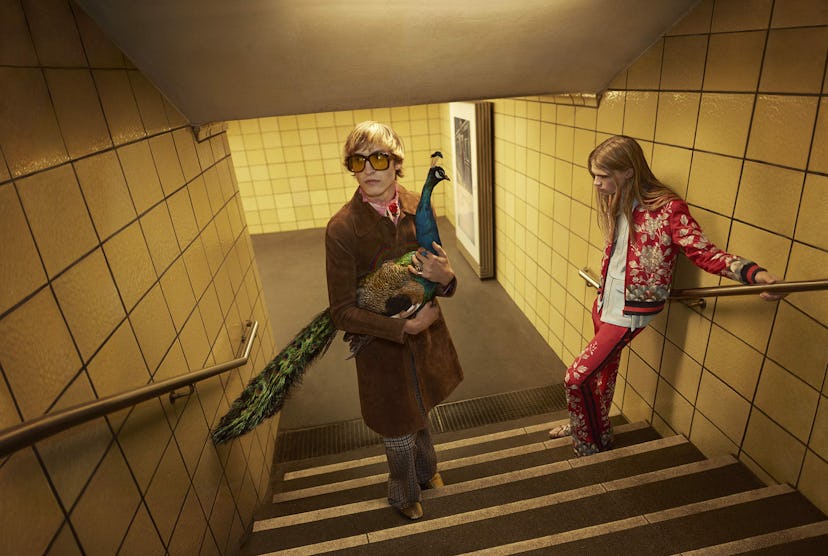How Gucci’s Alessandro Michele Changed “Peacocking”
The “new” peacocks don’t get care about attention from the opposite sex. They just crave attention.

The term “peacocking” has been used for years to describe males who ostentatiously put themselves on display. In Italy, especially in Florence, it’s thrown about constantly to label a certain strain of flamboyant street style personality.
But since becoming Gucci creative director, Alessandro Michele has redefined the meaning of the phrase with collections for the storied Italian house that play with traditional concepts of masculinity and menswear. Take, for instance, his spring campaign, where his fascination with gender is on plain view: an actual male peacock, down to its brilliant spotted ‘eye’ tail, is center stage, acting as a mediator between two men underground in a Berlin metro station. Neither of them look at each other, but the peacock’s eyes do all the talking, much like they would in an actual mating ritual.
While the concept of “peacocking” stems from Charles Darwin’s theory that female peacocks choose their mates based on the magnificence and maintenance of their plumage, shifts in sexual attitudes and gender politics have allowed designers like Michele, among others, to turn it on its head with clothes that seem to have other goals in mind: What happens when male peacocks decide they want to impress other male peacocks? Or don’t really care about gender at all?
One such person is Simone Marchetti, fashion editor at the Italian newspaper La Repubblica and someone who might be said to embody the new peacock archetype, and not just because he can usually be counted to wear Michele’s Gucci head to toe. “Prada is cold now; Gucci is hot. You can feel it,” he said.
Speaking from Florence, where he was attending Pitti Uomo, Marchetti passionately pontificated about why Michele’s sexually ambiguous aesthetic has struck a chord with men.
“As ‘peacocks,’ men are more free now than ever before,” he said. “Men got bored with classic dressing. I speak with lots of buyers, and they say that men and women don’t want to dress classic anymore—they want to dream again. It’s like the return of a Tom Ford era. The message and the dream are more important than a beautiful suit.”
Michele himself alluded to Tom Ford in an interview with W in December: “Tom worked with this idea that sexiness was like a god, something you could adore and wanted to be. But what does a girl want to be now? That goddess of Tom has changed. She wants to be the goddess of the streets, a goddess of tenderness. Maybe even she wants to be completely ambiguous.”
Marchetti personally experienced the impact of Michele’s Gucci not that long ago.
“When I bought the red blouse from Alessandro’s first collection, my colleagues thought I was completely mad,” he recalled. “But when I put it on, I felt like the atmosphere was really changing around me. I was not gay. I was not a peacock. I was something else—something unexpected. And at the same time, something very attractive. This is when fashion really works. It’s deeper than what anyone is imagining.”
As he walked around the streets of Florence, no doubt getting snapped in his Gucci finery, another thought occurred to him.
“The new consumer is gender-less. They don’t want to be recognized as homosexual, straight, or something else. It’s not important for them,” he said.
Then what is important? “Instagram and the selfie culture plays an important role. We know it’s good—the more you get recognized by your friends and a bigger audience,” he concluded.
So there it was: the new peacocks don’t care who they’re attracting, men or women, just as long as they’re attracting someone. In short, they know, like Darwin did, that it’s those with the best plumage who will stand out in a crowd.
Photos: How Gucci’s Alessandro Michele Changed “Peacocking”
Photo by Glen Luchford for Gucci.
Simone Marchetti. Photo by Adam Katz Sinding.
Photo by Glen Luchford for Gucci.
The first Gucci blouse Simone bought from Alessandro Michele’s Fall 2015 Collection.
Simone Marchetti. Photo by Adam Katz Sinding.
Photo by @marchettisimone.
Photo by @marchettisimone.
Photo by @marchettisimone.
Photo by @marchettisimone.
Photo by @marchettisimone.
Photo by @marchettisimone.
Photo by @marchettisimone.
Photo by Adam Katz Sinding.
Photo by Adam Katz Sinding.
Photo by Adam Katz Sinding.
Photo by Adam Katz Sinding.
Photo by Adam Katz Sinding.
Photo by Adam Katz Sinding.